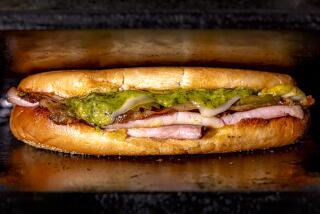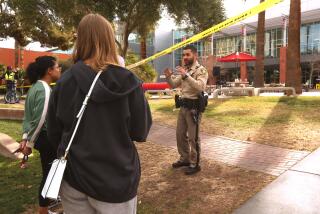Vestiges of Las Vegas’ glory days

Like residents in many cities, longtime Las Vegans long for what’s long gone — the days when a young Wayne Newton crooned “Danke Schoen” and dealers knew players by their first names.
“It was better in the old days when the mob was still here,” said Aiko Shono, a 35-year resident of Sin City. “Everyone had a job, everyone was friendly [and] people were not rude.”
Over big, juicy steaks and tender lyonnaise potatoes, Shono and her dining companion, Iris Buck, sighed as they reminisced.
“They ripped down all the old casinos that had so much history,” Buck said. “It’s a real shame. It’s not what it used to be when the Rat Pack was still here. And, you know, new is not always better.”
Buck and her husband became so disillusioned with all the changes that they left Las Vegas in 1999 for the peace and quiet of Idaho. She comes back once a year on business, and during her stays, tries to recapture at least a little of the city’s oft-imploded past.
It’s not necessarily easy to find remnants of what old-timers call the city’s heyday, but those who know where to look can still find Sin City’s unique history, outside the confines of a museum.
Shono and Buck make a point of enjoying dinner at one such spot: the Golden Steer ([702] 384-4470, golden.snapsweb.com), a restaurant with minimal curb appeal just a couple of blocks west of the Sahara resort, the most-recent piece of Old Vegas to bite the dust.
If you enter when it’s still light outside, your eyes will need a minute to adjust to the dark wood paneling and burgundy carpet. The Golden Steer looks like something from the set of the movie “Casino,” except it looked like this long before the 1995 movie. The Steer opened in 1958, and its appearance has not changed since then.
“The food’s excellent, and this is Old Vegas,” Shono said. “That’s why I come.”
Shono has seen plenty of celebrities at the Steer, she said, including Rat Packers Frank Sinatra and Sammy Davis Jr., whose booths display brass plaques bearing their names. Guests can reserve one of their tables — or, if they prefer, one frequented by race car driver Mario Andretti, actress Marilyn Monroe or the King.
“Elvis Presley’s is the most-requested table we have,” said server Fernando Camacho, who has worked at the steakhouse since 1978.
“[The rock bands] Nirvana, Mötley Crüe, Twisted Sister, [and] Quiet Riot always ask for [Presley’s] table,” he added.
Camacho also remembers serving an infamous but regular diner: mob figure Anthony (Tony) “The Ant” Spilotro, a Chicago mobster who made his way to Vegas, where he became part of a casino skimming-embezzlement scheme. He was killed, along with his brother Michael, in 1986. His table is adjacent to the private entrance that was reserved for the gangster and his cronies.
“Anybody who came through that door had to kneel and kiss his ring,” Camacho said. “I’m serious. I saw it.”
Another Old Vegas dining experience isn’t known for its famous or infamous patrons. But at Tiffany’s ([702] 444-4459), it seems as though almost everyone at the old-fashioned drugstore lunch counter is a character.
It’s inside White Cross Drugs, along a now-seedy stretch of the Strip in the shadow of the Stratosphere, and has been in continuous operation since 1957, except for the five days in 2005 when it closed to film scenes for the movie “Lucky You,” which mostly didn’t win over critics.
Breakfast at Tiffany’s — yes, that’s what they call it — is served 24/7. A three-egg cheese omelet with home fries and toast fills a platter and costs $6.95. The priciest item on the menu — a 16-ounce T-bone — is $15.95.
Farther north along Las Vegas Boulevard, visitors can discover another gem from Sin City’s earlier days. Downtown, at El Cortez ([702] 385-5200, https://www.elcortezhotelcasino.com), some of the rooms remain just as they were when Bugsy Siegel owned the joint in the 1940s.
“Evolution happens,” said Mike Nolan, the hotel-casino’s general manager. He’s created some new suites with a South Beach vibe, but the original 50 rooms appear much as they did when the hotel was built in 1941. The second- and third-floor rooms — and a barber shop — are reached by the original, creaky stairs; there’s never been an elevator in the original wing.
The “vintage rooms” remain popular with some guests.
“They like to be in the old-fashioned rooms right above the casino,” Nolan said.
You can still find vestiges of long-gone properties downtown. Lighted signs that once welcomed guests have been restored and plugged in along Fremont Street and Las Vegas Boulevard. At the intersection of the two, an oversized horse, its rider dressed in colorful strands of neon, stands atop a pole near the eastern end of the Fremont Street Experience. It once welcomed people to the Hacienda, on land now occupied by Mandalay Bay.
Other salvaged, once-again shining signs include those from the Chief Court Hotel, the Flame restaurant and the genie’s lamp from the original Aladdin. (For details, click on “The Collection” at https://www.neonmuseum.org.)
As Shono observed, Vegas used to be a kinder, gentler place. But even back in the day, it was too crowded and crazed for some famous folks. They preferred the serenity and natural beauty of Spring Mountain Ranch.
Located about 20 miles west of the Strip, the ranch was, in the 1800s, a watering hole along a shorter, alternate route of the Old Spanish Trail.
In 1947, radio star Chet Lauck, half of the “Lum and Abner” show, bought the 520-acre ranch and built his personal retreat. The exterior of Lauck’s two-story home — now part of the beautiful Spring Mountain Ranch State Park ([702] 875-4141, https://www.parks.nv.gov/smr.htm) is made of locally quarried sandstone. Inside, the walls feature knotty pine. The ceiling beams are redwood. A huge fireplace and hearth in the great room are of brick removed from Los Angeles’ Olvera Street.
Volunteers lead visitors on tours through the house, which reeks of history. Among the many surprises is the “secret bedroom” built by a later owner, German actress Vera Krupp. It’s hidden behind pine panels in Krupp’s boudoir.
“She was the last person who lived here full-time and operated it as a cattle ranch,” said docent Sarah Murphy, who notes that the property was sold in the ‘60s to reclusive billionaire Howard Hughes.
“We’ve never had any proof that Mr. Hughes was ever here,” Murphy said but noted that his senior advisors used the place for weekend getaways. The heliport they built is now the site of the popular Super Summer Theatre ([702] 594-7529, https://www.supersummertheatre.org), which stages musicals each June through September, with the mountains providing a majestic backdrop.
More to Read
Sign up for The Wild
We’ll help you find the best places to hike, bike and run, as well as the perfect silent spots for meditation and yoga.
You may occasionally receive promotional content from the Los Angeles Times.






